Microeconomics Assignment: Elasticity, Surplus, and Deadweight Loss
VerifiedAdded on 2022/10/10
|6
|1083
|3
Homework Assignment
AI Summary
This microeconomics assignment delves into core economic concepts, examining the law of demand and its impact on consumer surplus, illustrating how falling prices increase consumer benefits through numerical examples. It analyzes how taxation leads to deadweight loss, explaining the relationship between price elasticity of demand and the magnitude of this loss, using graphical representations. The assignment then critiques government claims about high cigarette taxes, arguing that inelastic demand limits their effectiveness. Finally, it explores the implications of international trade, specifically the balance of trade and potential impacts on domestic employment. The assignment utilizes economic theories, graphical illustrations, and real-world examples to provide a comprehensive understanding of microeconomic principles.
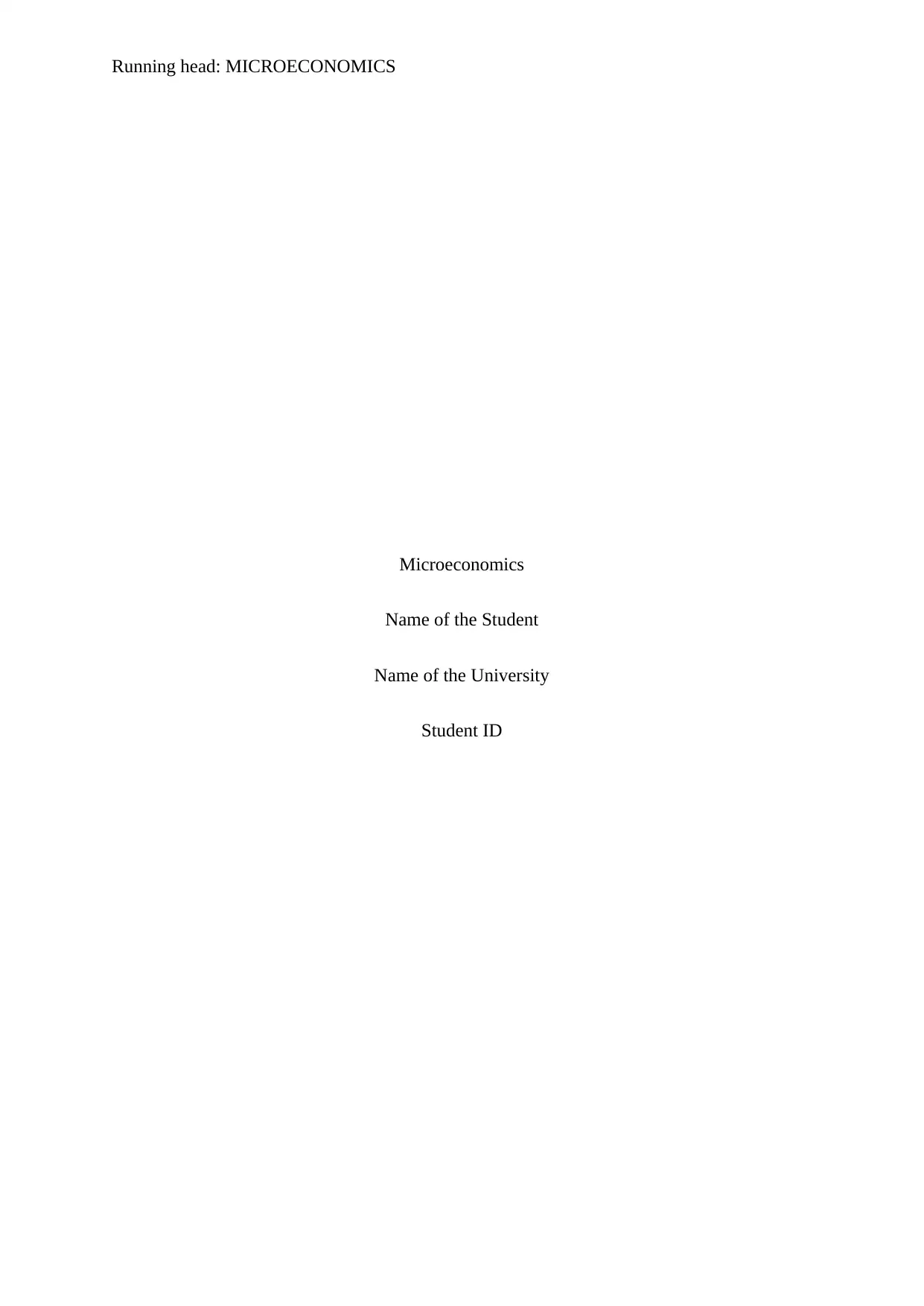
Running head: MICROECONOMICS
Microeconomics
Name of the Student
Name of the University
Student ID
Microeconomics
Name of the Student
Name of the University
Student ID
Paraphrase This Document
Need a fresh take? Get an instant paraphrase of this document with our AI Paraphraser

1MICROECONOMICS
Table of Contents
Answer 1....................................................................................................................................2
Answer 2....................................................................................................................................2
Answer 3....................................................................................................................................4
Answer 4....................................................................................................................................4
References..................................................................................................................................5
Table of Contents
Answer 1....................................................................................................................................2
Answer 2....................................................................................................................................2
Answer 3....................................................................................................................................4
Answer 4....................................................................................................................................4
References..................................................................................................................................5
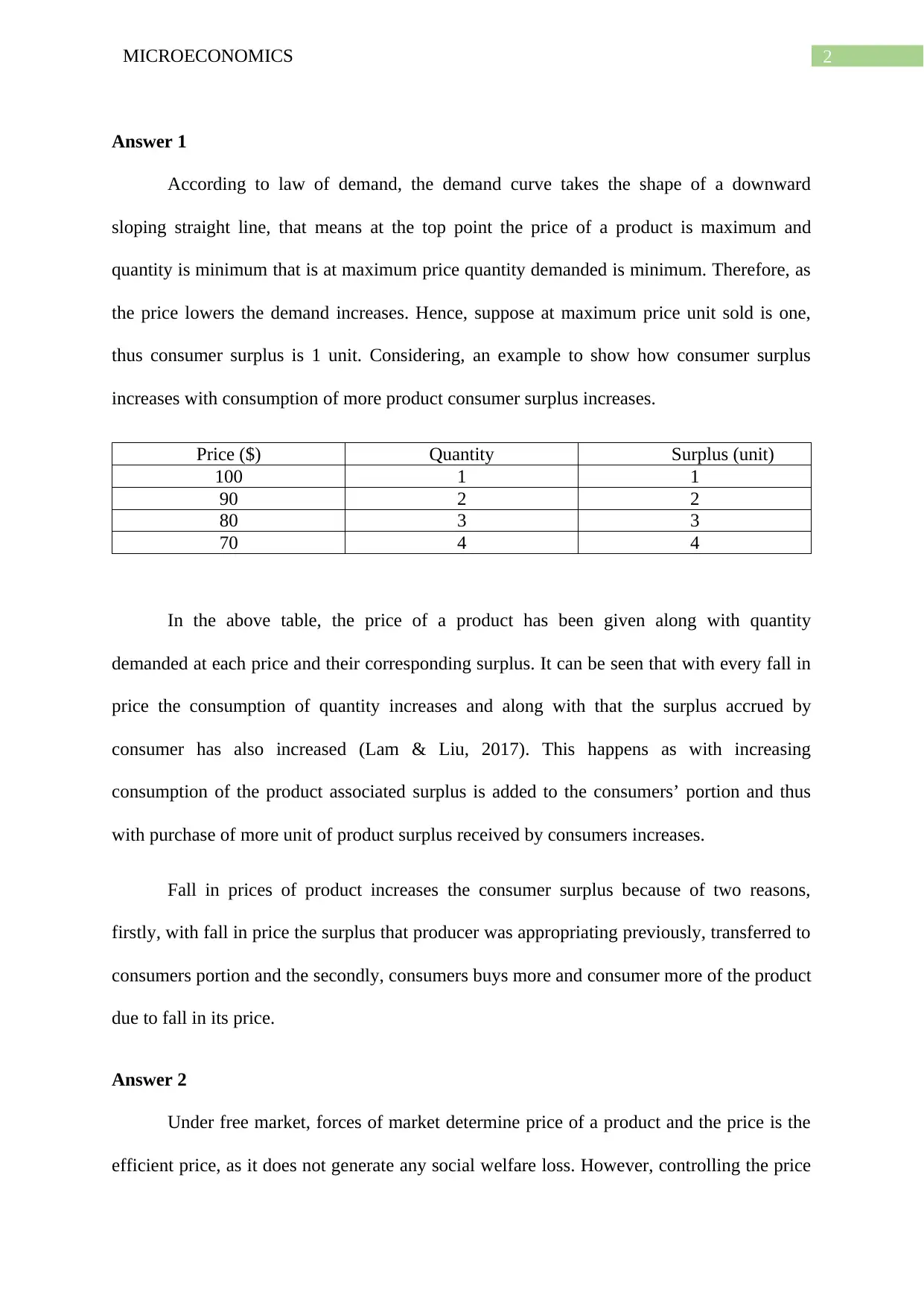
2MICROECONOMICS
Answer 1
According to law of demand, the demand curve takes the shape of a downward
sloping straight line, that means at the top point the price of a product is maximum and
quantity is minimum that is at maximum price quantity demanded is minimum. Therefore, as
the price lowers the demand increases. Hence, suppose at maximum price unit sold is one,
thus consumer surplus is 1 unit. Considering, an example to show how consumer surplus
increases with consumption of more product consumer surplus increases.
Price ($) Quantity Surplus (unit)
100 1 1
90 2 2
80 3 3
70 4 4
In the above table, the price of a product has been given along with quantity
demanded at each price and their corresponding surplus. It can be seen that with every fall in
price the consumption of quantity increases and along with that the surplus accrued by
consumer has also increased (Lam & Liu, 2017). This happens as with increasing
consumption of the product associated surplus is added to the consumers’ portion and thus
with purchase of more unit of product surplus received by consumers increases.
Fall in prices of product increases the consumer surplus because of two reasons,
firstly, with fall in price the surplus that producer was appropriating previously, transferred to
consumers portion and the secondly, consumers buys more and consumer more of the product
due to fall in its price.
Answer 2
Under free market, forces of market determine price of a product and the price is the
efficient price, as it does not generate any social welfare loss. However, controlling the price
Answer 1
According to law of demand, the demand curve takes the shape of a downward
sloping straight line, that means at the top point the price of a product is maximum and
quantity is minimum that is at maximum price quantity demanded is minimum. Therefore, as
the price lowers the demand increases. Hence, suppose at maximum price unit sold is one,
thus consumer surplus is 1 unit. Considering, an example to show how consumer surplus
increases with consumption of more product consumer surplus increases.
Price ($) Quantity Surplus (unit)
100 1 1
90 2 2
80 3 3
70 4 4
In the above table, the price of a product has been given along with quantity
demanded at each price and their corresponding surplus. It can be seen that with every fall in
price the consumption of quantity increases and along with that the surplus accrued by
consumer has also increased (Lam & Liu, 2017). This happens as with increasing
consumption of the product associated surplus is added to the consumers’ portion and thus
with purchase of more unit of product surplus received by consumers increases.
Fall in prices of product increases the consumer surplus because of two reasons,
firstly, with fall in price the surplus that producer was appropriating previously, transferred to
consumers portion and the secondly, consumers buys more and consumer more of the product
due to fall in its price.
Answer 2
Under free market, forces of market determine price of a product and the price is the
efficient price, as it does not generate any social welfare loss. However, controlling the price
⊘ This is a preview!⊘
Do you want full access?
Subscribe today to unlock all pages.

Trusted by 1+ million students worldwide
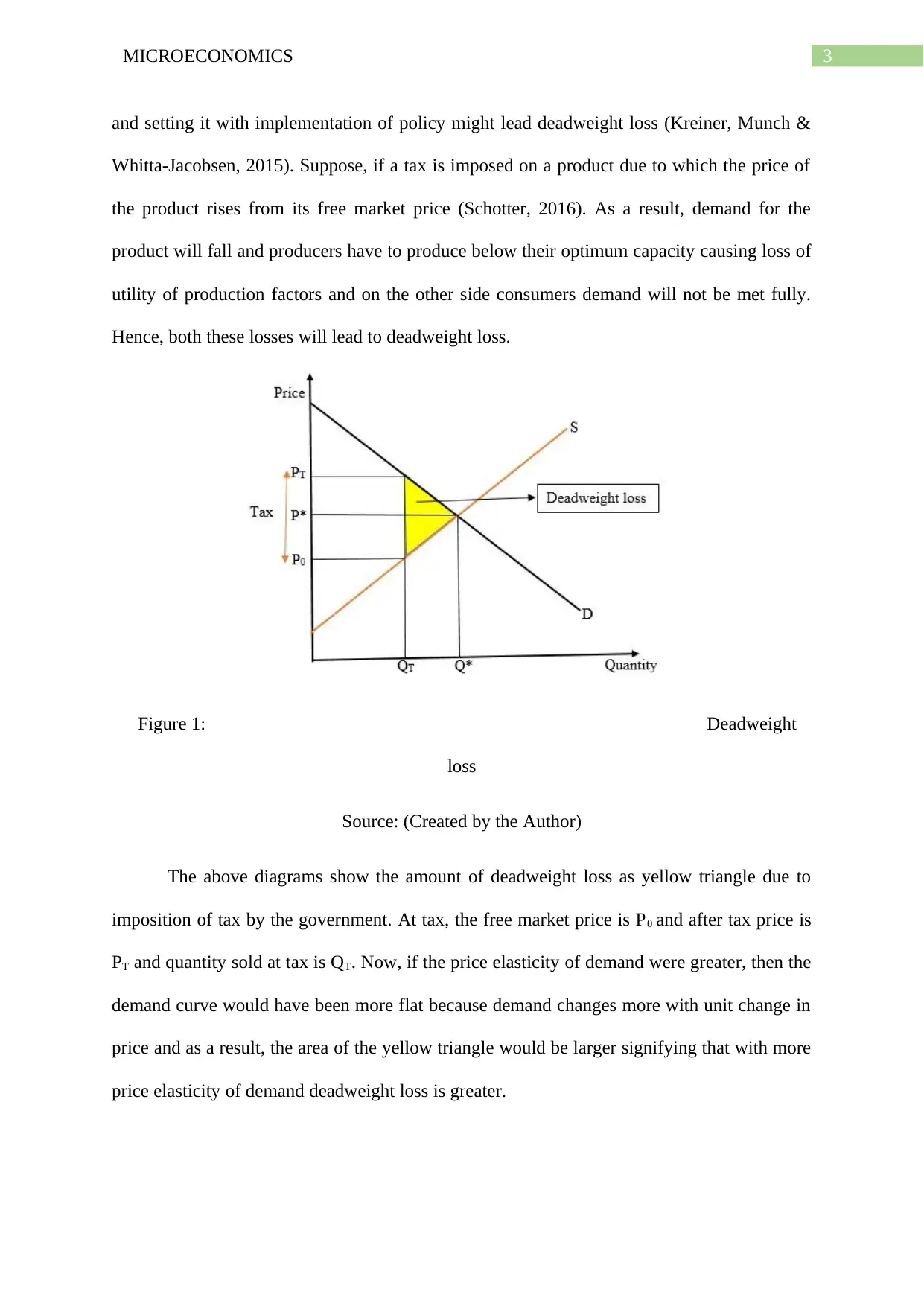
3MICROECONOMICS
and setting it with implementation of policy might lead deadweight loss (Kreiner, Munch &
Whitta-Jacobsen, 2015). Suppose, if a tax is imposed on a product due to which the price of
the product rises from its free market price (Schotter, 2016). As a result, demand for the
product will fall and producers have to produce below their optimum capacity causing loss of
utility of production factors and on the other side consumers demand will not be met fully.
Hence, both these losses will lead to deadweight loss.
Figure 1: Deadweight
loss
Source: (Created by the Author)
The above diagrams show the amount of deadweight loss as yellow triangle due to
imposition of tax by the government. At tax, the free market price is P0 and after tax price is
PT and quantity sold at tax is QT. Now, if the price elasticity of demand were greater, then the
demand curve would have been more flat because demand changes more with unit change in
price and as a result, the area of the yellow triangle would be larger signifying that with more
price elasticity of demand deadweight loss is greater.
and setting it with implementation of policy might lead deadweight loss (Kreiner, Munch &
Whitta-Jacobsen, 2015). Suppose, if a tax is imposed on a product due to which the price of
the product rises from its free market price (Schotter, 2016). As a result, demand for the
product will fall and producers have to produce below their optimum capacity causing loss of
utility of production factors and on the other side consumers demand will not be met fully.
Hence, both these losses will lead to deadweight loss.
Figure 1: Deadweight
loss
Source: (Created by the Author)
The above diagrams show the amount of deadweight loss as yellow triangle due to
imposition of tax by the government. At tax, the free market price is P0 and after tax price is
PT and quantity sold at tax is QT. Now, if the price elasticity of demand were greater, then the
demand curve would have been more flat because demand changes more with unit change in
price and as a result, the area of the yellow triangle would be larger signifying that with more
price elasticity of demand deadweight loss is greater.
Paraphrase This Document
Need a fresh take? Get an instant paraphrase of this document with our AI Paraphraser
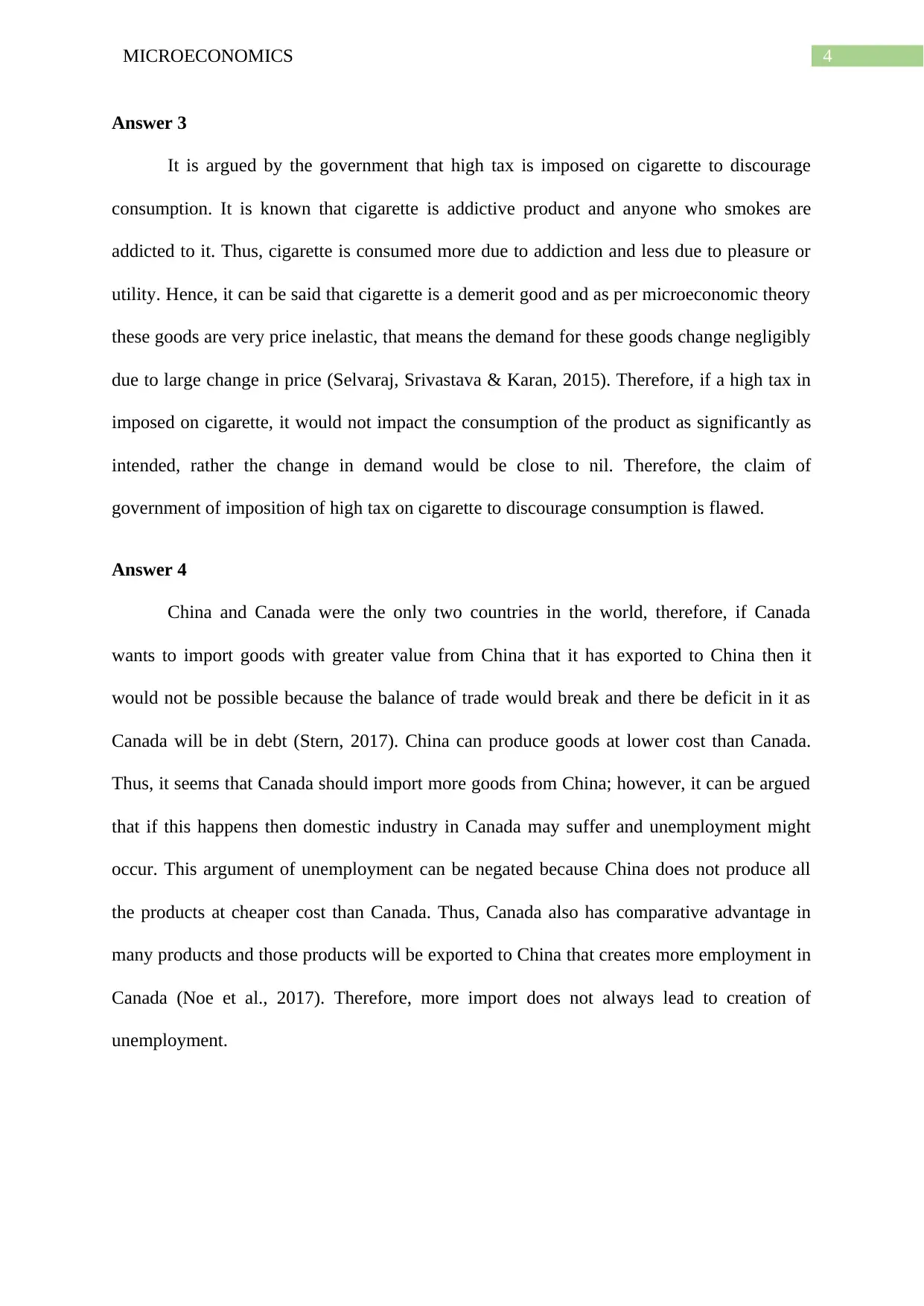
4MICROECONOMICS
Answer 3
It is argued by the government that high tax is imposed on cigarette to discourage
consumption. It is known that cigarette is addictive product and anyone who smokes are
addicted to it. Thus, cigarette is consumed more due to addiction and less due to pleasure or
utility. Hence, it can be said that cigarette is a demerit good and as per microeconomic theory
these goods are very price inelastic, that means the demand for these goods change negligibly
due to large change in price (Selvaraj, Srivastava & Karan, 2015). Therefore, if a high tax in
imposed on cigarette, it would not impact the consumption of the product as significantly as
intended, rather the change in demand would be close to nil. Therefore, the claim of
government of imposition of high tax on cigarette to discourage consumption is flawed.
Answer 4
China and Canada were the only two countries in the world, therefore, if Canada
wants to import goods with greater value from China that it has exported to China then it
would not be possible because the balance of trade would break and there be deficit in it as
Canada will be in debt (Stern, 2017). China can produce goods at lower cost than Canada.
Thus, it seems that Canada should import more goods from China; however, it can be argued
that if this happens then domestic industry in Canada may suffer and unemployment might
occur. This argument of unemployment can be negated because China does not produce all
the products at cheaper cost than Canada. Thus, Canada also has comparative advantage in
many products and those products will be exported to China that creates more employment in
Canada (Noe et al., 2017). Therefore, more import does not always lead to creation of
unemployment.
Answer 3
It is argued by the government that high tax is imposed on cigarette to discourage
consumption. It is known that cigarette is addictive product and anyone who smokes are
addicted to it. Thus, cigarette is consumed more due to addiction and less due to pleasure or
utility. Hence, it can be said that cigarette is a demerit good and as per microeconomic theory
these goods are very price inelastic, that means the demand for these goods change negligibly
due to large change in price (Selvaraj, Srivastava & Karan, 2015). Therefore, if a high tax in
imposed on cigarette, it would not impact the consumption of the product as significantly as
intended, rather the change in demand would be close to nil. Therefore, the claim of
government of imposition of high tax on cigarette to discourage consumption is flawed.
Answer 4
China and Canada were the only two countries in the world, therefore, if Canada
wants to import goods with greater value from China that it has exported to China then it
would not be possible because the balance of trade would break and there be deficit in it as
Canada will be in debt (Stern, 2017). China can produce goods at lower cost than Canada.
Thus, it seems that Canada should import more goods from China; however, it can be argued
that if this happens then domestic industry in Canada may suffer and unemployment might
occur. This argument of unemployment can be negated because China does not produce all
the products at cheaper cost than Canada. Thus, Canada also has comparative advantage in
many products and those products will be exported to China that creates more employment in
Canada (Noe et al., 2017). Therefore, more import does not always lead to creation of
unemployment.
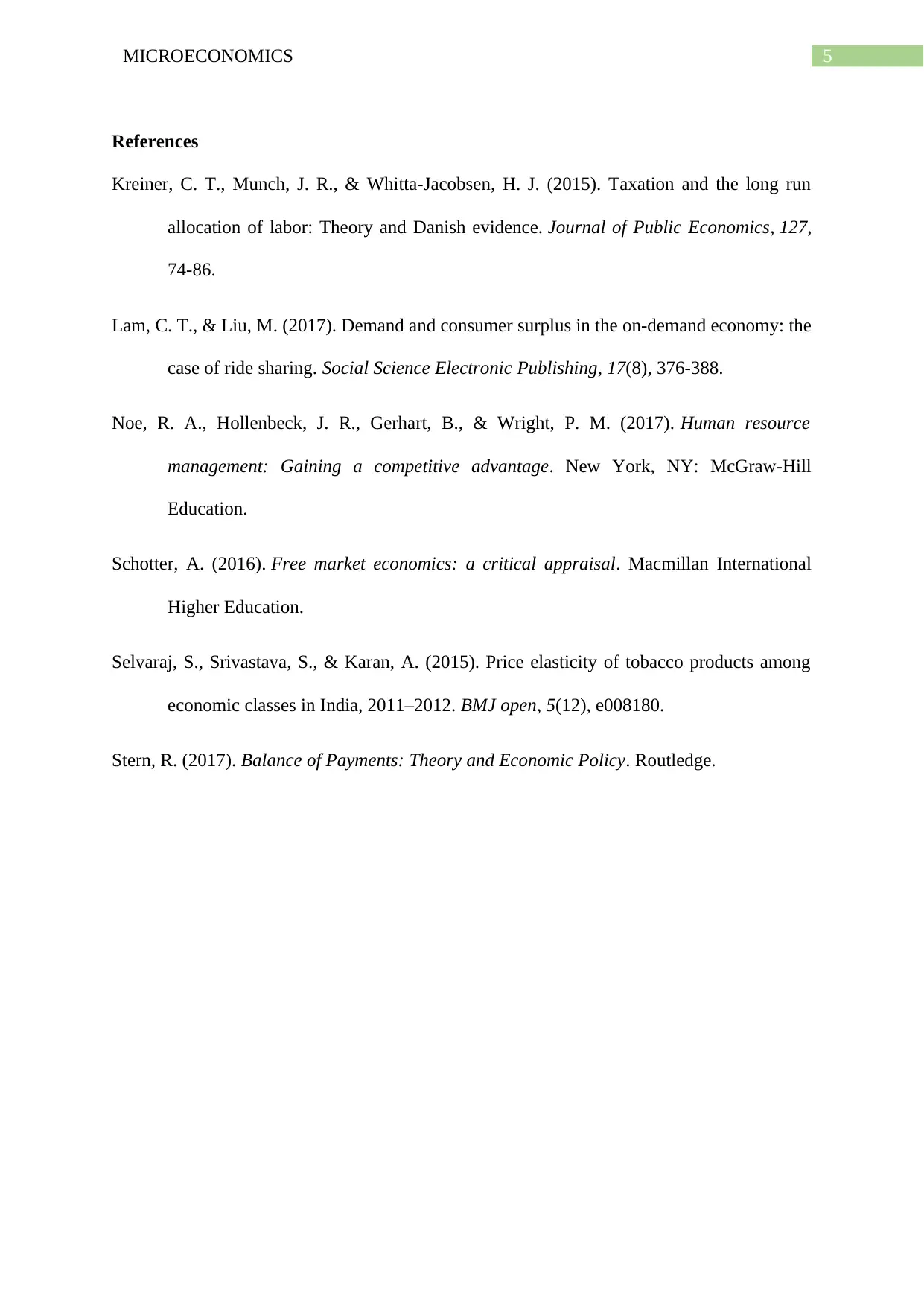
5MICROECONOMICS
References
Kreiner, C. T., Munch, J. R., & Whitta-Jacobsen, H. J. (2015). Taxation and the long run
allocation of labor: Theory and Danish evidence. Journal of Public Economics, 127,
74-86.
Lam, C. T., & Liu, M. (2017). Demand and consumer surplus in the on-demand economy: the
case of ride sharing. Social Science Electronic Publishing, 17(8), 376-388.
Noe, R. A., Hollenbeck, J. R., Gerhart, B., & Wright, P. M. (2017). Human resource
management: Gaining a competitive advantage. New York, NY: McGraw-Hill
Education.
Schotter, A. (2016). Free market economics: a critical appraisal. Macmillan International
Higher Education.
Selvaraj, S., Srivastava, S., & Karan, A. (2015). Price elasticity of tobacco products among
economic classes in India, 2011–2012. BMJ open, 5(12), e008180.
Stern, R. (2017). Balance of Payments: Theory and Economic Policy. Routledge.
References
Kreiner, C. T., Munch, J. R., & Whitta-Jacobsen, H. J. (2015). Taxation and the long run
allocation of labor: Theory and Danish evidence. Journal of Public Economics, 127,
74-86.
Lam, C. T., & Liu, M. (2017). Demand and consumer surplus in the on-demand economy: the
case of ride sharing. Social Science Electronic Publishing, 17(8), 376-388.
Noe, R. A., Hollenbeck, J. R., Gerhart, B., & Wright, P. M. (2017). Human resource
management: Gaining a competitive advantage. New York, NY: McGraw-Hill
Education.
Schotter, A. (2016). Free market economics: a critical appraisal. Macmillan International
Higher Education.
Selvaraj, S., Srivastava, S., & Karan, A. (2015). Price elasticity of tobacco products among
economic classes in India, 2011–2012. BMJ open, 5(12), e008180.
Stern, R. (2017). Balance of Payments: Theory and Economic Policy. Routledge.
⊘ This is a preview!⊘
Do you want full access?
Subscribe today to unlock all pages.

Trusted by 1+ million students worldwide
1 out of 6
Related Documents
Your All-in-One AI-Powered Toolkit for Academic Success.
+13062052269
info@desklib.com
Available 24*7 on WhatsApp / Email
![[object Object]](/_next/static/media/star-bottom.7253800d.svg)
Unlock your academic potential
Copyright © 2020–2025 A2Z Services. All Rights Reserved. Developed and managed by ZUCOL.





